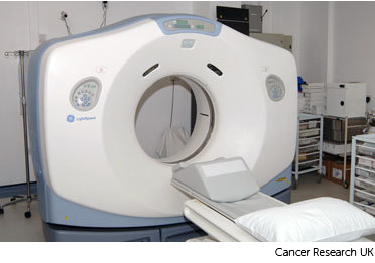Planning radiotherapy for bone cancer
Radiotherapy uses high energy x-rays to kill cancer cells. External beam radiotherapy is the use of radiation to destroy cancer cells from outside of the body.
The radiotherapy team plan your radiotherapy before you start your treatment for primary cancer.
Planning your treatment
The radiotherapy team plan your external radiotherapy before you start treatment. This means working out the dose of radiotherapy you need and exactly where you need it.
Your planning appointment takes from 15 minutes to 2 hours.
You usually have a planning CT scan in the radiotherapy department.
The scan shows the cancer and the area around it. You might have other types of scans or x-rays to help your treatment team plan your radiotherapy. The plan they create is just for you.

Your radiographers tell you what is going to happen. They help you into position on the scan couch. You might have a type of firm cushion called a vacbag to help you keep still.
The CT scanner couch is the same type of bed that you lie on for your treatment sessions. You need to lie very still. Tell your radiographers if you aren't comfortable.
Injection of dye
You might need an injection of contrast into a vein in your hand. This is a dye that helps body tissues show up more clearly on the scan.
Before you have the contrast, your radiographer asks you about any medical conditions or allergies. Some people are allergic to the contrast.
Having the scan
Once you are in position your radiographers put some markers on your skin. They move the couch up and through the scanner. They then leave the room and the scan starts.
The scan takes about 5 minutes. You won't feel anything. Your radiographers can see and hear you from the CT control area where they operate the scanner.
Radiotherapy shell (mould)
Your treatment team might make a plastic mould (shell) for you. This is to keep your arm or leg still during the treatment sessions.
You wear the shell for each treatment session. The radiographers might make marks on the shell. They use the marks to line up the radiotherapy machine for each treatment.
The process of making the shell can vary slightly between hospitals. It usually takes around 30 minutes.
Before making the shell
The radiographers explain what will happen during the procedure and what clothes you need to take off. You need to wear clothes that you can easily take off from your arm or leg. You also need to remove any jewellery from that area.
Making the shell
A technician or radiographer uses a special kind of plastic that they heat in warm water. This makes it soft and pliable. They put the plastic around the treatment area so that it moulds exactly to your shape.
After a few minutes the plastic gets hard. The technician takes the shell off and it's ready to use.
Vacuum bag mould
A vaccum bag mould is used during your treatment to help keep you still and in the right position.
Your radiographer might make a mould using a plastic cushion filled with tiny polystyrene balls. They mould the cushion around the treatment area and then suck out the air with a vacuum pump.
This moulds the cushion very closely around your body and the radiographer removes the pump. The cushion then forms a solid and firm support each time you have treatment. The cushion is called a vac pac.
Ink marks
Once the treatment team has planned your radiotherapy, they might put ink marks on your skin. This is to make sure they treat exactly the same area every day. They may also make pin point sized tattoo marks in these areas.
After your planning session
You might have to wait a few days or up to 3 weeks before you start treatment.
During this time the physicists and your radiotherapy doctor (clinical oncologist) decide the final details of your radiotherapy plan. They make sure that the area of the cancer will receive a high dose and nearby areas receive a low dose. This reduces the side effects you might get during and after treatment.
This page is due for review. We will update this as soon as possible.



